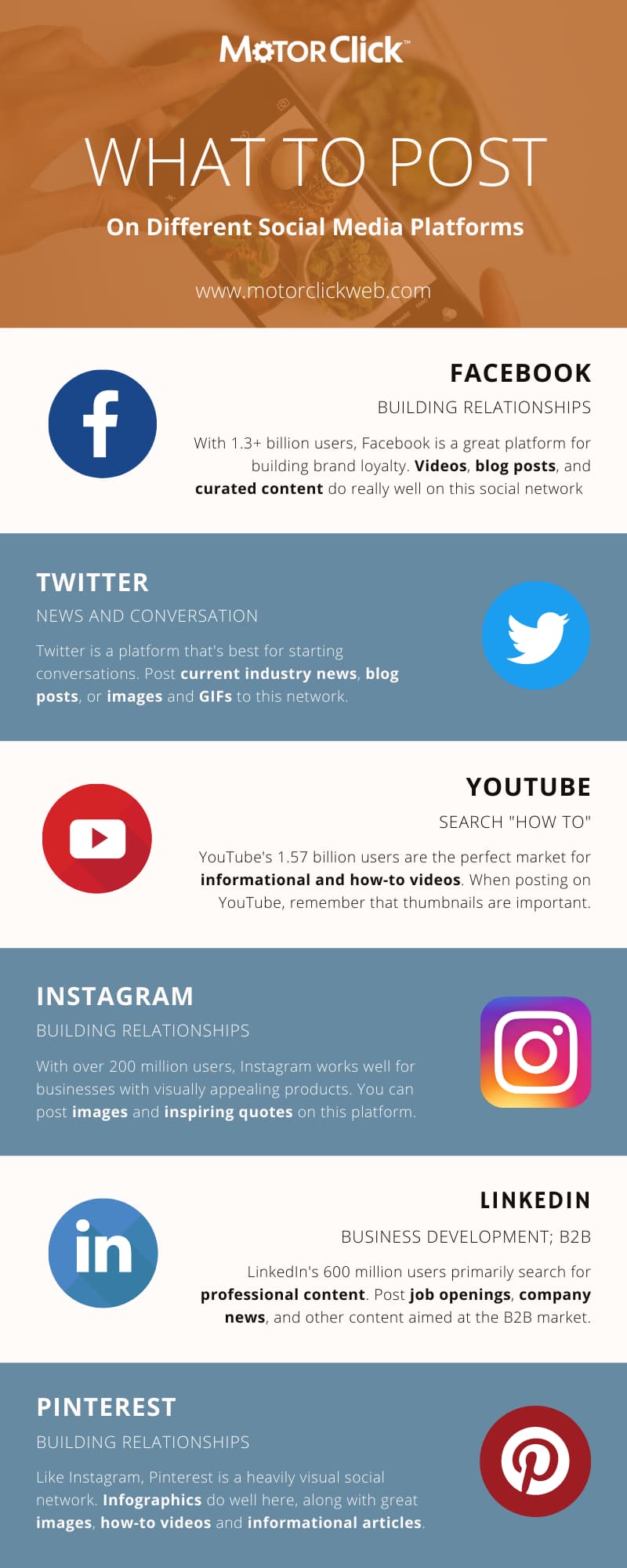Having an online presence is crucial to the survival of any business, especially smaller local businesses. One easy way to help establish this presence (aside from a great website, of course) is through use of social media. The trouble is, most people don’t know how to use social media the right way. There are so many things they could be doing to make social media work for their organization that they don’t even know about! In this post, we give you some tips to help you take your social media to the next level.
7 minutes
There are many cost-effective ways you can take your local business’ social media strategy to the next level to reach more customers and improve your SEO. Let’s dive in!
1. Set goals that work for your organization
Before you start posting, ask why you want to have these social media accounts. Is it to increase awareness of your brand or grow your audience? Or maybe you want to use it to boost your sales or increase traffic to your company website? Do you really need them at all, or would your business be better off without them? Take some time to really think through your goals. When deciding on them, try not to think about what your competitors are doing.
Once you know your end-game, set smaller goals to help you get there. Make sure these goals are specific, measurable, attainable, relevant, and timely (SMART). Depending on your objectives, you’ll want to track different metrics. Below is a quick reference table to help you figure out which metrics fit which objectives.
| Business Objective | Social Media Goal | Metric(s) |
|---|---|---|
| Grow the brand | Awareness | Followers, shares, etc. |
| Create brand ambassadors | Engagement | Comments, likes, mentions, etc. |
| Boost sales/Increase web traffic | Conversions | Website clicks, email signups, etc. |
| Improve customer retention | Consumer | Testimonials, social media sentiment, average response time (customer service), etc. |
Setting up ground rules
Regardless of your goal(s), you will want to come up with some ground rules for engaging with your followers. People will post complaints, ask questions, and share their experiences with your brand. Will you reply to every comment, or only so many per post? How will you respond to negative comments? And how should you respond if someone mentioned you without tagging you? Having a plan for handling these things can help you maximize your time and effort. Not to mention, it can help you avoid potential problems whenever you get a negative comment or review.
2. Post on a regular basis
It’s easy to let social media completely slip off your radar. After all, you have an organization to run! But taking time to post regularly on social media is important.
Remember that a lot of people search for and follow local businesses on social media. Active profiles attract followers because people find value in their content, whether they post articles, anecdotes from their office life, or giveaways. When you leave your profile inactive for too long, you unintentionally turn people away. They see the value isn’t there, so they search for it somewhere else: your competition.
Once you decide which social media accounts you want to maintain for your business, make a commitment to engage. If it helps, schedule time in your day to post, or if you can, have someone on your team take on this responsibility. The benefits of social media are well worth it if you put in the time and effort to post on a regular basis!
3. Know what to post on which platform (and when)
Before you post something, carefully consider which platform fits your content best. Depending on what content you have, certain social platforms might be a better fit than others. Not only is the type of content important, but also the time you decide to post it. We’ve created a great infographic to help you choose the right social media platforms for your content:

4. Use relevant metadata
On certain social media platforms – like Twitter, Facebook, and Instagram – you can use hashtags to help your local audience find your posts. Hashtags are a form of metadata that help users search for a certain place, topic, or theme. For example, a bakery that specializes in gluten free cakes might use tags like these:
#baking #cakedecorating #dessert #sweets #cakesofinstagram #glutenfree
Once these hashtags are a part of the post, anyone searching about those topics will see that post in their results. Someone interested in cake decorating might search that hashtag for posts that she likes, and she might see yours and like what you posted. If she likes it enough, she might decide to follow you or share your content with her friends.
Hashtags allow you to reach people beyond the boundaries of your own follower list, word-of-mouth, and print advertising, if you use them correctly. That said, don’t go overboard and stuff your post with hashtags. Not sure which ones you should use? Apps like Tag o’Matic can help you find the right hashtags to fit your content. While searching, don’t forget to consider hashtags for your city or town, as this can help you pop up in local searches.
5. Diversify your content
To take your social media strategy to the next level, consider adding some variety to your posts. Share different kinds of things, like behind-the-scenes company photos or vlogs. You could also post industry-relevant news, articles from your blog or other related blogs that you follow, or polls and giveaways. Whatever you post, make sure it is relevant to your customer!
To find out what works for your business, don’t be afraid to experiment a little. Most major social media platforms come with analytics tools to help you track engagement. Post something and see how your followers respond. Then post more of the things they like and engage with, and less of the things they tend to ignore.
And one more thing: don’t be afraid to post the same content more than once! There is no rule that says you can only post something once ever on the internet. It’s important to keep in mind that not all of your followers will see your content immediately after you post it. Some may see it hours later, and others not at all. With so many companies posting great content on social media, what you posted an hour or two ago will have already been buried under a mountain of new posts! Obviously, take care not to go overboard with reposting things – otherwise you’ll irritate your followers. Experiment with this a bit, and watch how your audience responds.
6. Solve problems, don’t sell!
Ads bombard us everywhere we turn, so much so that we’ve trained ourselves to ignore them. A company that only tries to push their products on their followers will have a tough time getting anyone to take the bait. We’re not saying you should never try to sell to customers. But we are saying you need to think carefully about how you’re selling.
Social media gives you so many great opportunities to solve customers’ problems. If your followers have questions, answer them. Give them helpful information, point them to your support team, or create content to directly address some of the most common problems your audience faces.
By solving problems and providing value, you position your brand as the authority in your industry. And you gain peoples’ trust. Remember, you need to build relationships with people in order to make them commit to your organization. Invest in the relationship, and the rest will take care of itself!
7. Use awesome media
One last great way to level up your social media strategy is to incorporate media. Certain social media platforms, like Pinterest and Instagram, focus mainly on image- and video-centered content. A wedding venue, for instance, could feature breathtaking photos of the property, of happy couples during their wedding reception. They could even post a virtual tour of the venue. Likewise, a chef could post still photos of his finished dishes or video tutorials for his favorite recipes. How can you make images, graphics, and videos work well for your business?
Conclusion
Social media has the potential to give your business a significant boost in exposure and customer engagement. To take things a step further, you should set goals, post on a regular basis, and know what to post where and when. Additionally, adding relevant metadata, diversifying your content types, and using awesome interactive media can boost engagement and turn customers into brand ambassadors. And don’t forget: solve problems, don’t just sell your product.
What have you tried that helped you level up your social media strategy? Let us know in the comments!

